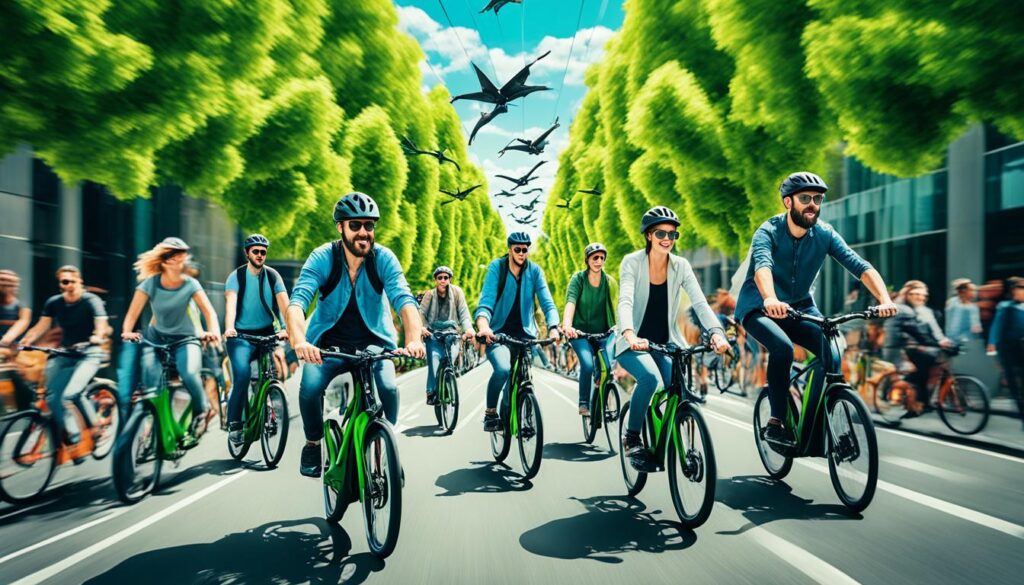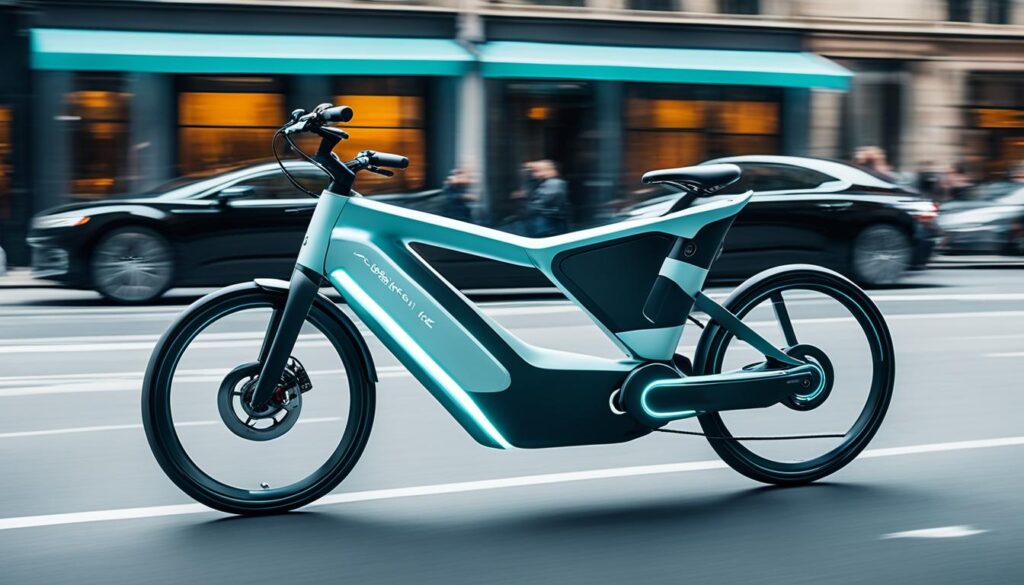Riding an electric bike, or e-bike, is now a cool and green way to get around town or the countryside. Many riders often wonder if it’s safe to ride their e-bike when it rains. Thanks to modern water-resistant technology, e-bikes can handle the rain. But, to keep them running smoothly and keep riders safe, there are important things to do and avoid. This guide will show you how to ride in the rain safely and keep your e-bike in top shape.
Key Takeaways
- Electric bikes are designed with water-resistant features, allowing safe usage in wet conditions.
- Understanding trail closures and opting for paved or gravel surfaces can help avoid damaged trails and maintain safety.
- Avoid riding through deep water to protect the e-bike’s motor and battery.
- Post-ride maintenance, such as cleaning and drying your e-bike, is crucial to preventing long-term wear and tear.
- Modifications like installing fenders and adjusting tire pressure enhance comfort and safety when riding in the rain.
- Checking the Ingress Protection (IP) rating of your e-bike ensures it is suited for the wet weather you plan to tackle.
- Proper storage and regular maintenance are key to preserving the quality of an e-bike, especially after exposure to rain.
Understanding the Water-Resistance of Electric Bikes
Electric bikes are changing the way we travel. They blend efficiency, being green, and new tech perfectly. An essential feature is their water resistance. It comes from electric bike components that handle different weather well. Most e-bikes have a standardized IP-45 rating. This rating means they’re good at keeping out dust and water.
The Sealed Units of Motors and Batteries
The power of an electric bike lies in its sealed motors and sealed batteries. These pieces keep moisture out and protect the bike’s core from water damage. For instance, Macfox electric bikes have a waterproof level 4 rating. They can handle splashes and low-pressure water jets, perfect for wet cities and muddy paths.
Durability of Electric Components
The durability of electric bike parts is constantly getting better. As innovations come, the standard for water resistance goes up. This shows how the electric bike market is adapting to tough environments without losing quality.
Big brands are also upping their testing game. They invest a lot to make sure their bikes do more than just meet the needed IP ratings. This leads to e-bikes that are strong and perform well. They can handle rain and different temperatures well, avoiding conditions that could hurt the battery.
Riding Your Electric Bike in Wet Conditions: Tips and Tricks
When it starts to rain, riding an electric bike might seem risky. But, if you have an adventurous spirit and follow wet weather tips, you can have a safe and fun ride. These strategies and tips will guide you through the rain safely and joyfully.
Get ready for rainy rides by taking advantage of sales, like a spring sale that offers up to $1,500 discount on select electric bikes and up to 50% off on gear. Buying the right gear for rainy weather will protect your bike and keep you safe and comfortable.
Wet conditions mean you need to be extra careful, even though e-bikes are very water-resistant. It’s important to be cautious not only because of the rain but because it can make roads and trails more dangerous. Avoid paths that may be closed after it rains or during bad weather.
Keeping your e-bike clean after riding in rain or mud is crucial. It helps prevent damage. Also, get your bike ready for rain by adding fenders and lowering tire pressure for better traction.
Make sure you’re seen and ride safely by braking earlier and avoiding leaning on lines when turning on wet roads. Wearing waterproof clothes like jackets, pants, and gloves will help you stay dry and focused on your ride.
If you’re looking for an e-bike good for rainy weather, check out models like Embolden E+ or Intrigue X E+. Hiboy bikes are designed for wet conditions with fat puncture-resistant tires, hydraulic suspension forks, and 750W motor power. With 48V 13Ah batteries, they offer a range of up to 60 miles, great for long rides in the rain.
Learning from others is key to making good choices. About 68% of riders share concerns online about wet conditions, while 42% give tips like using waterproof covers. Sharing experiences helps everyone prepare for rainy bike rides better.
| Feature | Benefit |
|---|---|
| Water-resistant components | Enables safe usage in rain |
| Preventive wash after wet rides | Reduces wear and extends bike life |
| Visibility measures | Improves safety in low-light conditions |
| Lower tire pressure for better traction | Enhances grip on slippery surfaces |
| Waterproof attire | Protects the rider from rain |
Safety Precautions for Navigating Rainy Days on an E-Bike
E-bikes are becoming more popular. This makes it vital to talk about safety precautions for rainy weather. A lot of cyclists have been hit by cars in the U.S. since the pandemic started. This points out how crucial it is to be more visible and careful on the road. When it’s wet out, roads get slippery. Cyclists need to be extra careful to keep their bike under control.
Reduced Visibility and Slippery Surfaces
Rain makes it harder to see and causes slippery roads. These issues raise the risk for e-bike riders. Studies show cyclists face more dangers than cars, especially when it’s hard to see. To stay safe, riders should wear reflective clothes and use bright lights on their e-bikes. Being careful on slippery roads can also stop many crashes.
Importance of Wearing Proper Gear
In the UK, cyclists face more severe injuries per kilometer than car drivers. This shows how important wearing the right gear is. A helmet is a must. Waterproof clothing protects against bad weather. It also makes the commute safer and comfier. Clothes that make riders more visible can stop accidents caused by drivers not seeing bikes.
Maintaining Tire Pressure and Traction
The right tire pressure is key to preventing accidents when it rains. Too much pressure decreases traction on wet roads. Not enough pressure makes it hard to steer. Following the manufacturer’s advice on tire pressure can help you keep a good grip and control. Keeping an eye on injury and death statistics shows how vital these details are for safety.
Studies from low- and middle-income countries show that being proactive about safety precautions helps. Riders should always put safety first. They should wear the right gear, take care of their e-bikes, and learn the best ways to ride in bad weather. Focusing on safety can help bring down the number of accidents. It ensures that cycling remains a joy without the risk of preventable accidents.
Maintaining Your Electric Bike After Riding in the Rain
Just because you rode through rain, the care for your E-bike doesn’t stop. It is crucial to look after it after getting wet. This ensures it works well and lasts long. Even water-resistant electric bikes, like those from Trek, need care after rain. They require attention, especially to parts like the drivetrain and battery contact points.
Maintaining your bike avoids rust and keeps it running smoothly. For Trek bikes, this care keeps their battery management systems in top shape. Plus, it helps avoid the high costs of replacing electric bike batteries. So, making maintenance a routine is wise.
When cleaning your electric bike, always be gentle. Avoid using strong water jets as they can damage the bike’s enclosed parts. Trek’s safety-certified e-systems can handle a good clean. But, remember to store your bike correctly. Keep it away from extreme temperatures and bring the batteries inside when the weather’s bad. Having your E-bike checked regularly by professionals helps it resist bad weather.
Caring for your E-bike makes it last longer and perform better. From cleaning gently to easing drivetrain strain, every action counts. Spinning at the right speed also helps. It’s about more than just using the bike. This approach aims for long-term smooth riding. For complex issues, it’s best to go to a professional bike shop.



